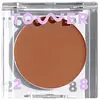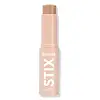What's inside
What's inside
 Key Ingredients
Key Ingredients

 Benefits
Benefits

No benefits
 Concerns
Concerns

 Ingredients Side-by-side
Ingredients Side-by-side

Hydrogenated Polybutene
Ricinus Communis Seed Oil
MaskingPolyhydroxystearic Acid
EmulsifyingHelianthus Annuus Seed Wax
Skin ConditioningDiisostearyl Malate
EmollientTriisostearyl Citrate
EmollientMicrocrystalline Wax
Emulsion StabilisingSilica
AbrasiveZea Mays Starch
AbsorbentJojoba Esters
EmollientButyrospermum Parkii Butter
Skin ConditioningOryza Sativa Bran Extract
Skin ConditioningMica
Cosmetic ColorantMangifera Indica Seed Butter
Skin ConditioningPrunus Avium Seed Oil
EmollientRosa Canina Seed Oil
EmollientCaprylyl Glycol
EmollientEthylhexylglycerin
Skin ConditioningCarthamus Tinctorius Seed Oil
MaskingHelianthus Annuus Extract
EmollientAcacia Decurrens Flower Wax
EmollientPolyglycerin-3
HumectantRosmarinus Officinalis Leaf Extract
AntimicrobialTocopherol
AntioxidantCamellia Sinensis Leaf Extract
AntimicrobialChamomilla Recutita Flower Extract
MaskingTocopheryl Acetate
AntioxidantCI 77891
Cosmetic ColorantIron Oxides
Hydrogenated Polybutene, Ricinus Communis Seed Oil, Polyhydroxystearic Acid, Helianthus Annuus Seed Wax, Diisostearyl Malate, Triisostearyl Citrate, Microcrystalline Wax, Silica, Zea Mays Starch, Jojoba Esters, Butyrospermum Parkii Butter, Oryza Sativa Bran Extract, Mica, Mangifera Indica Seed Butter, Prunus Avium Seed Oil, Rosa Canina Seed Oil, Caprylyl Glycol, Ethylhexylglycerin, Carthamus Tinctorius Seed Oil, Helianthus Annuus Extract, Acacia Decurrens Flower Wax, Polyglycerin-3, Rosmarinus Officinalis Leaf Extract, Tocopherol, Camellia Sinensis Leaf Extract, Chamomilla Recutita Flower Extract, Tocopheryl Acetate, CI 77891, Iron Oxides
Diisopropyl Dimer Dilinoleate
EmollientLauryl Laurate
Skin ConditioningCaprylyl Methicone
Skin ConditioningPolyethylene
AbrasiveHydrated Silica
AbrasiveParaffin
PerfumingSynthetic Beeswax
Emulsion StabilisingZeolite
AbsorbentDimethicone/Vinyl Dimethicone Crosspolymer
Skin ConditioningCopernicia Cerifera Wax
Boron Nitride
AbsorbentCaprylyl Glycol
EmollientSilica
AbrasiveHydrogenated Soybean Oil
EmollientPhenoxyethanol
PreservativeStearic Acid
CleansingHexylene Glycol
EmulsifyingMicrocrystalline Wax
Emulsion StabilisingDimethicone
EmollientTriethoxycaprylylsilane
Alumina
AbrasiveIron Oxides
CI 77891
Cosmetic ColorantDiisopropyl Dimer Dilinoleate, Lauryl Laurate, Caprylyl Methicone, Polyethylene, Hydrated Silica, Paraffin, Synthetic Beeswax, Zeolite, Dimethicone/Vinyl Dimethicone Crosspolymer, Copernicia Cerifera Wax, Boron Nitride, Caprylyl Glycol, Silica, Hydrogenated Soybean Oil, Phenoxyethanol, Stearic Acid, Hexylene Glycol, Microcrystalline Wax, Dimethicone, Triethoxycaprylylsilane, Alumina, Iron Oxides, CI 77891
Alternatives
Ingredients Explained
These ingredients are found in both products.
Ingredients higher up in an ingredient list are typically present in a larger amount.
Caprylyl Glycol is a humectant and emollient, meaning it attracts and preserves moisture.
It is a common ingredient in many products, especially those designed to hydrate skin. The primary benefits are retaining moisture, skin softening, and promoting a healthy skin barrier.
Though Caprylyl Glycol is an alcohol derived from fatty acids, it is not the kind that can dry out skin.
This ingredient is also used as a preservative to extend the life of products. It has slight antimicrobial properties.
Learn more about Caprylyl GlycolCi 77891 is a white pigment from Titanium dioxide. It is naturally found in minerals such as rutile and ilmenite.
It's main function is to add a white color to cosmetics. It can also be mixed with other colors to create different shades.
Ci 77891 is commonly found in sunscreens due to its ability to block UV rays.
Learn more about CI 77891Microcrystalline Wax is created by de-oiling petroleum. It is highly refined and purified before being added to cosmetics.
Microcrystalline Wax is used to enhance the texture and create even consistency. It helps stabilize a product by preventing ingredients from separating.
Silica, also known as silicon dioxide, is a naturally occurring mineral. It is used as a fine, spherical, and porous powder in cosmetics.
Though it has exfoliant properties, the function of silica varies depending on the product.
The unique structure of silica enhances the spreadability and adds smoothness, making it a great texture enhancer.
It is also used as an active carrier, emulsifier, and mattifier due to its ability to absorb excess oil.
In some products, tiny microneedles called spicules are made from silica or hydrolyzed sponge. When you rub them in, they lightly polish away dead skin layers and enhance the penetration of active ingredients.
Learn more about SilicaThis ingredient is a combination of red, black, and yellow iron oxide pigments. This combination of colors is usually found in foundation, because it results in a "skin" color.